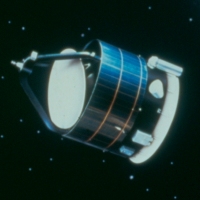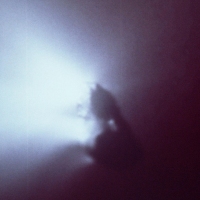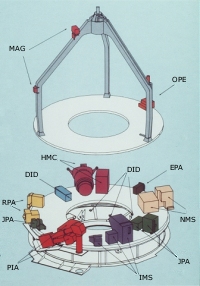Giotto 20 Years On
13 March 2006
On the night of 13 March 1986 the Giotto spacecraft passed within 600 km of the core of comet 1P/Halley. Launched eight months earlier on 2 July 1985, Giotto was the first spacecraft to visit a comet's nucleus and represented ESA's first deep space mission.The Mission
 |
|
Artist's impression of Giotto |
Comet 1P/Halley was the logical choice for a cometary encounter mission. Aside from its fame with the public, Halley is a young, highly active comet and with 30 recorded apparitions its nature and orbit are perhaps the best understood of any comet.
Giotto was one of a small armada of spacecraft sent to rendezvous with Halley – two Soviet, two Japanese and one from NASA. An agreement was set up between the various agencies and information passed on to the Giotto team, which was the last to fly-by the comet, to help the final targeting of the spacecraft.
After successfully completing its goal to rendezvous with and observe Halley's comet, Giotto went into hibernation for four years. Although a few of the instruments were damaged during the encounter the spacecraft had survived the battering by cometary dust and a second cometary fly-by, this time of comet 26P/Grigg-Skjellerup, took place in July 1992.
Launch and Orbit
The launch of Giotto took place at 11:23 UT, 2 July 1985 by an Ariane-1 rocket from the European spaceport in Kourou. The spacecraft entered a 10-month solar orbit and eight months into its first orbit passed comet Halley at a distance of 596 km.
Having completed six full orbits in five years, the orbital positions of Giotto and the Earth coincided in July 1990. Following an Earth gravity-assist manoeuvre, another ESA first, Giotto was placed on a two-year intercept course for a second cometary encounter with 26P/Grigg-Skjellerup.
Table of Events
|
Date |
Time (UT) |
Event |
Distance to nucleus (km) |
|
Halley Encounter | |||
| 2 July 1985 | 11:23 | Launch by Ariane-1 rocket | |
| 12 March 1986 | 21:00 | First detection hydrogen ions | 7.8 million |
| 13 March 1986 | 19:40 | Crossing of bowshock | 1.15 million |
| 20:15 | Start of formal 4-hour close encounter | ||
| 22:01 | First dust impact of ~12 000 in total | 290 000 | |
| 14 March 1986 | 00:02:54 | Spacecraft sent spinning by impact of large (~1 gram) particle, resulting in loss of signal on Earth | |
| 00:03:02 | Closest approach to comet Halley's nucleus | 596 | |
| 00:35 | Spacecraft stabilised, continuous contact with Earth restored | ||
| 00:52 | Detection of last dust impact | ||
| 02:15 | End of formal 4-hour close encounter | ||
| 15 March 1986 | 02:00 | Instruments turned off | |
| 2 April 1986 | Spacecraft enters hibernation | ||
|
Grigg-Skjellerup Encounter | |||
| 24 February 1990 | Spacecraft reactivated | ||
| 2 July 1990 | Earth gravity assist at 22 730 km; observations of Earth's magnetic field and energetic particle environment | ||
| 24 February 1990 | Spacecraft enters hibernation | ||
| 8 May 1992 | Spacecraft reactivated | ||
| 10 July 1992 | Detection of first cometary ions | 440 000 | |
| First sign of entering the dust coma | 17 000 | ||
| 15:30:43 | Closest approach to Grigg-Skjellerup | 100 | |
| 23 July 1992 | Mission End | ||
Spacecraft
Giotto was a cylindrical spacecraft approximately 1.87m in diameter and 2.85m high. At launch the spacecraft weighed 960 kg, although by the time of its encounter with comet 1P/Halley this had reduced to 574 kg.
An aluminium core supported three aluminium platforms:
- Upper: Despun antenna and telecommunications equipment
- Central: Four propellant tanks
- Lower: Experiment payload behind a dust shield to protect the payload from the high-speed dust particles during the comet encounter
Electrical power came from a solar array, made from over 5000 silicon cells wrapped around the cylindrical exterior of the spacecraft, providing 190 Watts during the comet Halley encounter.
The spacecraft was spin-stabilised as it rotated at 15 rpm around the main axis. During the encounter with comet Halley the spacecraft approached with its dust shield and spin axis pointing towards the nucleus. The despun antenna, tilted at 44.3° to the spin axis, continually pointed to the Earth to ensure non-stop communications.
Instruments
The spacecraft carried 10 experiments, with the majority housed behind the dust shield, weighing 60kg:
- A camera for imaging
- Three mass spectrometers for analysis of elements and isotopic composition of dust and gas
- A photo-polarimeter to measure coma's brightness
- A suite of plasma instruments for studying solar-wind/comet interaction
Science Results
 |
|
Nucleus of comet 1P/Halley |
In total 2112 images were returned of comet Halley's nucleus with the last at a distance of 1372 km, 18 seconds before closest approach. They revealed an elongated nucleus that was larger than expected, measuring 15 km long, 7-10 km wide.
Measurements confirmed that comet Halley had formed 4.5 × 109 years ago from ices condensing onto grains of interstellar dust and remained almost unaltered in the cold outer Solar System.
One of the main surprises from the Giotto mission though, was the discovery that comets are not dirty snowballs, but are mostly composed of dust, with the ice embedded.
A summary of the key results from the Halley encounter:
- Only 2-4% of the incident light is reflected by the comet's surface making it among the most darkest objects in the Solar System
- Only a small fraction (~10%) of the nucleus was active
- The density was determined to be fairly low, at < 0.6 g/cm3
- Molecular composition indicated a complex chemistry:
- most dust particles were rich in hydrogen, carbon, nitrogen
and oxygen
- minerals and organic components present - Dust particles were recorded with masses between 10-17 and 4×10-2 g
- Deduced dust production rate ~ 3 × 106 g/s
- Smoke-particle sized grains were much more abundant than expected and they were organic instead of stony
- The comet's ionosphere size followed theoretic predictions:
- bowshock in solar wind at 1.15 × 106 km
- contact surface at 4700 km - Inside the contact surface the magnetic field strength was nearly zero as predicted
Legacy
The success of Giotto inspired a succession of cometary encounter missions including ESA's Rosetta mission. Rosetta is due to encounter comet 67 P/Churyumov-Gerasimenko in 2014. On arrival, it will orbit the comet and will deploy a lander to determine the physical characteristics of both the surface and subsurface.

